
 |
This was a night of disappointment followed by sudden thrills. July 18/19th looked like an interesting day for a number of reasons. One of these reasons was a risk of thunderstorms over N. Ireland and due to cloudy days and nights with uninteresting weather during much of the week I was getting an itchy 'shutter finger' and felt eager to do some photography. Since I have been nurturing a major interest in convective/storm photography I was very much looking forward to some action. The first risk was a very low level threat during the afternoon but unfortunately the storms never formed, however I wasn't surprised by this given the synoptics. There was however some highly unstable skies with thundery looking elevated convection which looked like it came close to exploding several times. The afternoon was full of heavy showers and widespread displays of Altocumulus Castellanus. The night event was the main attraction. Due to a series of fronts/troughs sweeping across N. Ireland the chances of some organized thunderstorms looked good during the night between 00.00 and 06.00 BST. I did have my heart set on this and was planning a long, and probably exhausting (even dangerous) night. My plan was to begin imaging the sky from evening twilight onwards with the intention of catching the convection against a backdrop of twilight and stars, with perhaps even an NLC display. I was then going to capture atmospheric shots of the Moon with storm clouds sweeping past then relocate to the country and image lightning during the night. I was going to stay out all night long and then capture the Sun rising over the horizon. With this plan in mind, and with the batteries charged, I was ready and waiting.
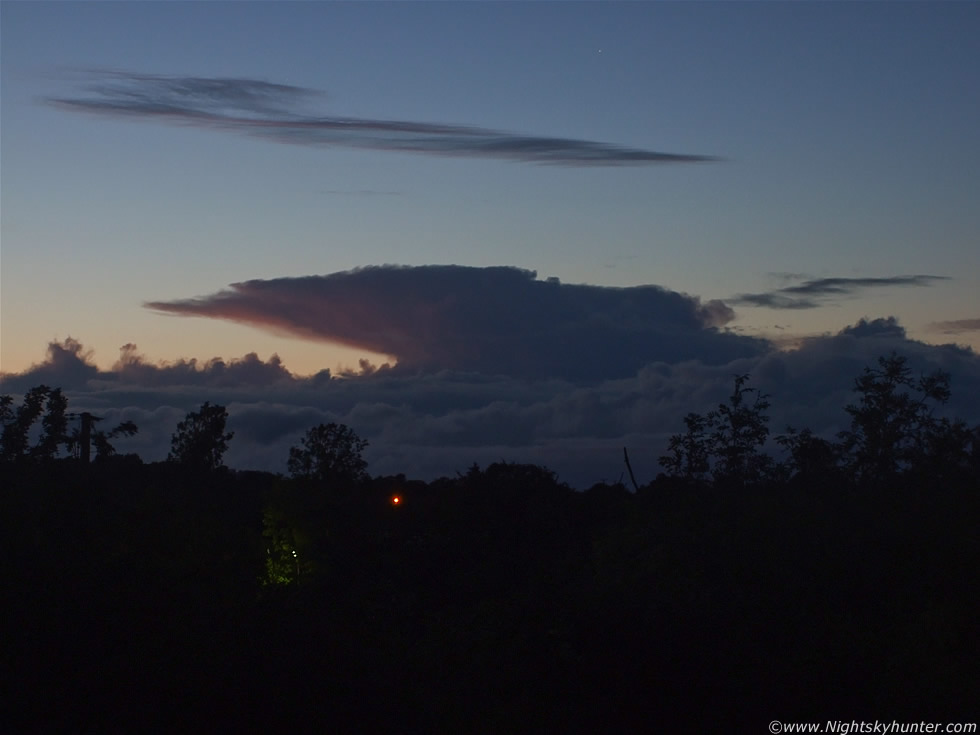 |
22.57 BST. The first part of my plan went without a hitch. The clouds and rain during the evening died away at sunset and as darkness fell across the land I spotted some good looking convection against the twilight sky. The last time I seen good convective cells at night was during early May when we had a stunning nocturnal thunderstorm so I was quite pleased to see this very large cumulonimbus cell some distance away on the N horizon. The stars where already present with plenty on view at the zenith however the twilight was still advanced lower in the sky. You can see Capella within Auriga at the top of the frame. Despite this time of the night I was amazed to see some scattered red sunlight illuminating the underside of the anvil. The cell itself is embedded within a broken blanket of convection and is moving from L to R. This was taken from a high vantage point which I use for NLC surveys. Behind the tree tops is the Coleraine Road. Beyond this is dark countryside which eventually meets the Sperrin Mountains many miles away. You can see mammatus pouches and some sinking air falling from the underside. What I wouldn't have gave to have seen an NLC display behind the anvil!.
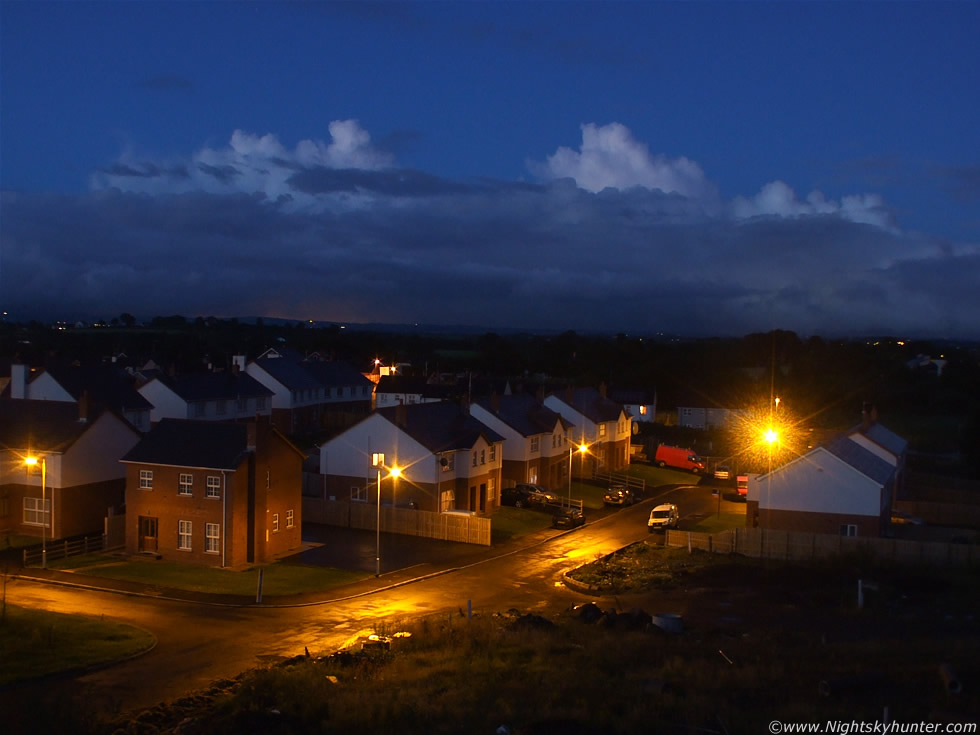 |
23.01 BST. Looking along the NE to E horizon at a line of quite tall convection against the night sky. These cumulus towers were lit a strange white colour by the full Moon which was low in the E and out of frame to the R. That's Willow Glynn in the foreground. It would have been a treat to see some lightning activity from these.
I went home and checked the internet for any further data on the storm potential and was informed that the chances were now very small thanks to the latest GFS update. I was bitterly disappointed and checked the radar to get a better feel on the situation. There where more showers sweeping down from the NW so perhaps there was some potential for images anyway. At least there was good clear periods with quite a remarkable starry sky given the bright moonlight. Feeling semi-defeated I phoned my friend John McConnell from Maghaberry for some astronomy chat. At 01.26 BST we watched a very bright high level pass of the International Space Station (ISS) as it crept through Ophiuchus then only a few degrees below Altair in Aquila the 'celestial Eagle' before fading into the E sky. At 01.35 BST we decided to end the call but just before that happened John let a yell out of him. I kept saying ''what is it?'', then after a period of silence he informed me that an incredible moonbow was visible. I told him to go out and get images (he was already taking images anyway - no need to tell John) so we ended the call and I let him get on with it. I got excited by the idea of moonbows and started to get into action mode. I have seen perhaps six or so moonbows in my life and each one of them was worth seeing and unforgettable to say the least. I recall spending an entire night out during the Winter this year in a field getting soaked by rain and hail trying to catch this very rare phenomena. I got one cool image but I accidentally deleted it so I decided to do my best to catch one tonight.
In theory 'Moonbows', 'Nocturnal Rainbows' or 'Lunar Rainbows' as I like to call them (the former) should be a common sight, but they are not. There are many people around the world who have spent their entire lives under the stars and never seen a single one. Just like day time bows their lunar cousins form in exactly the same way except the window of opportunity is smaller each month, plus you need unsettled weather too. So what do you need?.
1) You need a very bright Moon phase. The best bows appear around the full Moon period. That is to say, one to two days before full phase, full phase itself, and the two days after full. Bows can form from a gibbous or even a quarter Moon but they tend to be faint, lack colour, and require a trained eye to spot. The best thing to do in that situation is to take a time exposure of the sky opposite the Moon. Sometimes the camera can detect what the human eye can miss.
2) The height of the Moon will govern when and how large your bow will be. If the Moon is higher than 42 degrees (84 Moon diameters) above the horizon then a bow cannot form so you want to be hunting for them when the Moon is lower than this. A high Moon will create a very low bow so you will need a good horizon. A low Moon will create a high bow. Light pollution may hinder detection of a low bow however large intense displays may be seen from towns.
3) Weather and opposition. You need regular unsettled weather but not so bad that there is 100% cloud cover. A night of regular showers/storms would be your best bet, however the passage of cold front could be the best time. This is more so at the rear of the front when the clouds break revealing the stars and Moon, but is still producing rain/showers. The speed of the cloud is important to increase your chances of getting an image. You need rain falling in the region of sky opposite the Moon (ie: the Moon is behind your back) and you need the Moon to be in a clear section of sky in order for its light to hit the rain drops. If these two areas are not in sync, or the clouds are moving very fast, then you will get a bow (usually faint) which appears to pulse, as in, appear and disappear on and off, and this 'off' part is most often likely during your exposure.
4) The luck factor. By this I mean that everything is falling into the place and the region above you is dry so you can shoot in comfort. Most of the time there will be rain falling on you and your camera so you will need to take your images in a hurry before your lens gets battered. To increase your chances of success you should have your camera settings pre-selected after sunset to save valuable time when a bow does form. I learned this lesson from personal experience during the Winter.
01.47 BST. Tonight the conditions looked perfect for bows. My Sister and I decided to go for a walk in the country with our Dog 'Benson'. We where on the road only a few min's when we seen our first spectacular bow of the night. This was facing NW, You can see a primary and secondary moonbow with convective clouds behind which where dropping rain below. Note that the primary bow continues into a clear sky where there are no clouds. This is because the outflow winds from the convective clouds where pushing the precipitation forward through the air in their direction of travel from NW to NE. You can see the stars of Ursa Major (Big Dipper or Plough) with Cor Caroli beside a curl of cloud on the left.
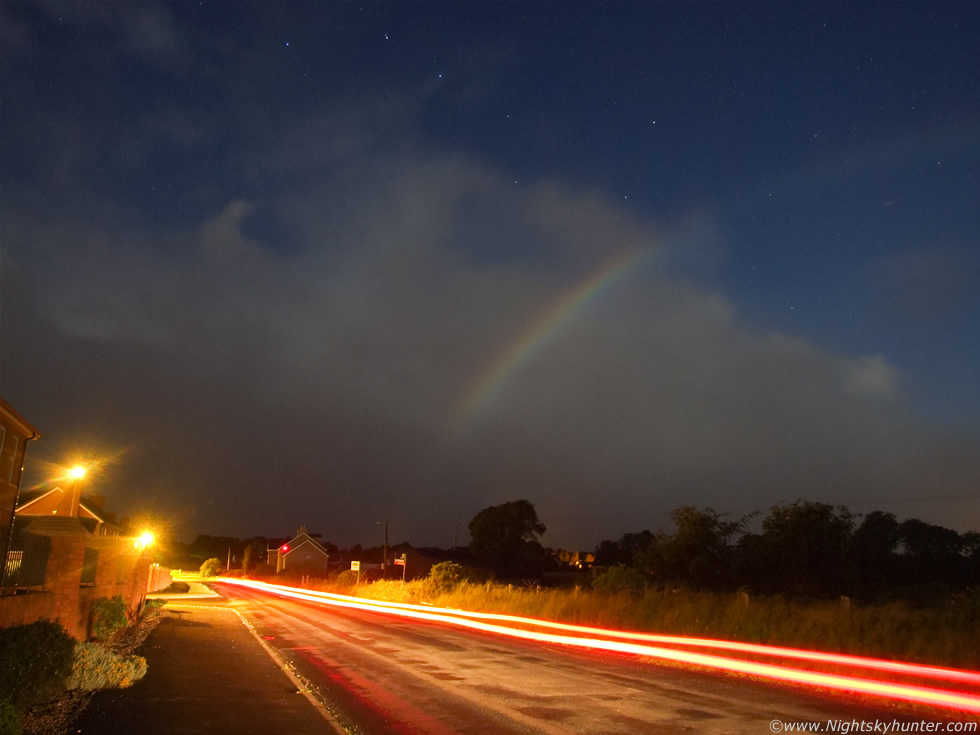 |
01.47 BST. We were very lucky because the bow never vanished but seemed to be intensifying. I set up the camera on the footpath with the intention of catching the bow and a few car trails. I was lucky to catch a few late night drivers. Here's the tail lights from a car moving away from the camera while the driver gave me very strange stares at the same time!. Note the slight dips in the light trail caused by the car going over bumps/dips in the road.
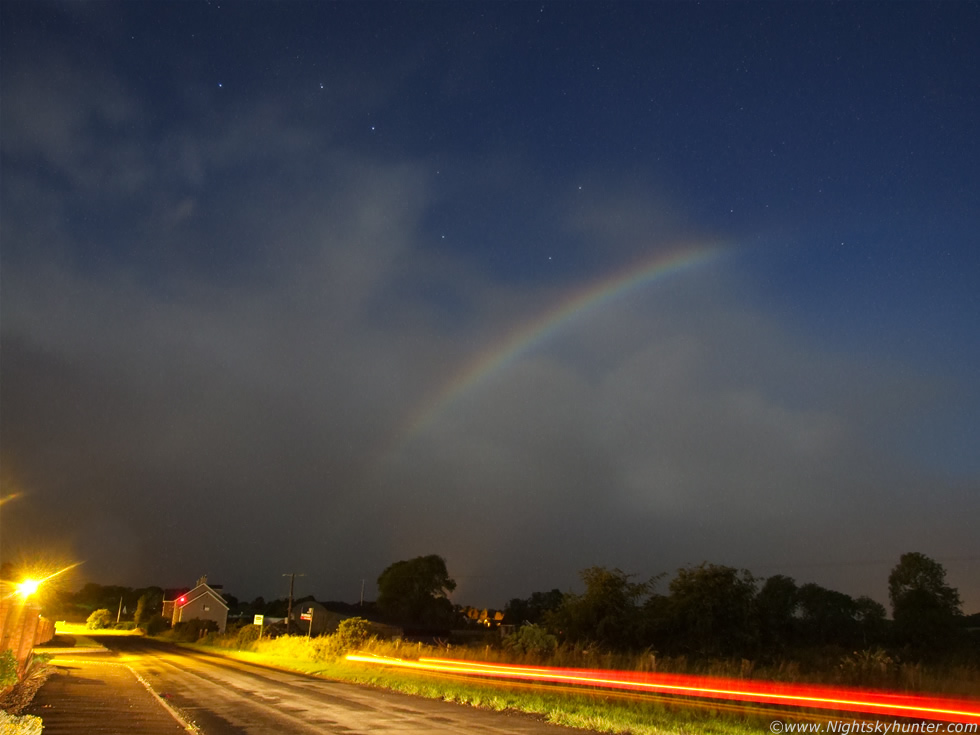 |
01.48 BST. I increased the exposure time and ISO for the rest of these images. This time, half a car trail. This bow seemed to last forever. My Sister and I just stood watching in amazement. Note how slow the clouds are moving in relation to the stars in the above three images.
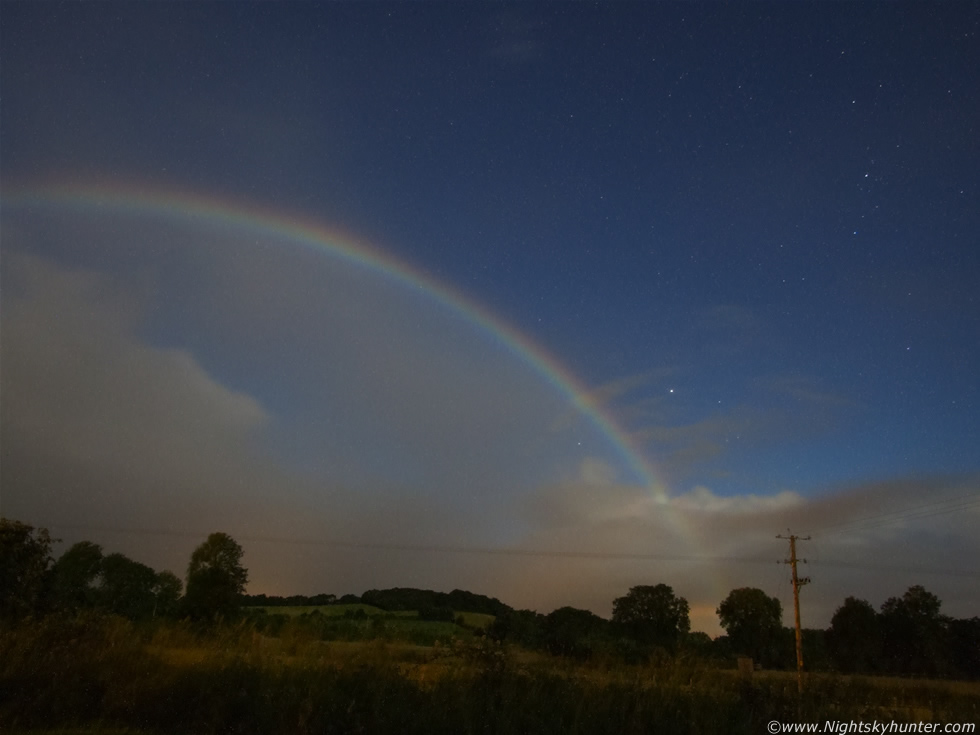 |
01.49 BST. The moonbow now was a complete arc within intense colours and magnitude. We could see the colours easily with the naked eye. Red on the outside and blue on the inside. This is the R section of the same bow. Camera taking in the N to E of N sky sector. The base of the bow is cutting straight through Auriga. Perseus and Camelopardalis can be seen to the upper R. I then put my camera away and we continued on our way.
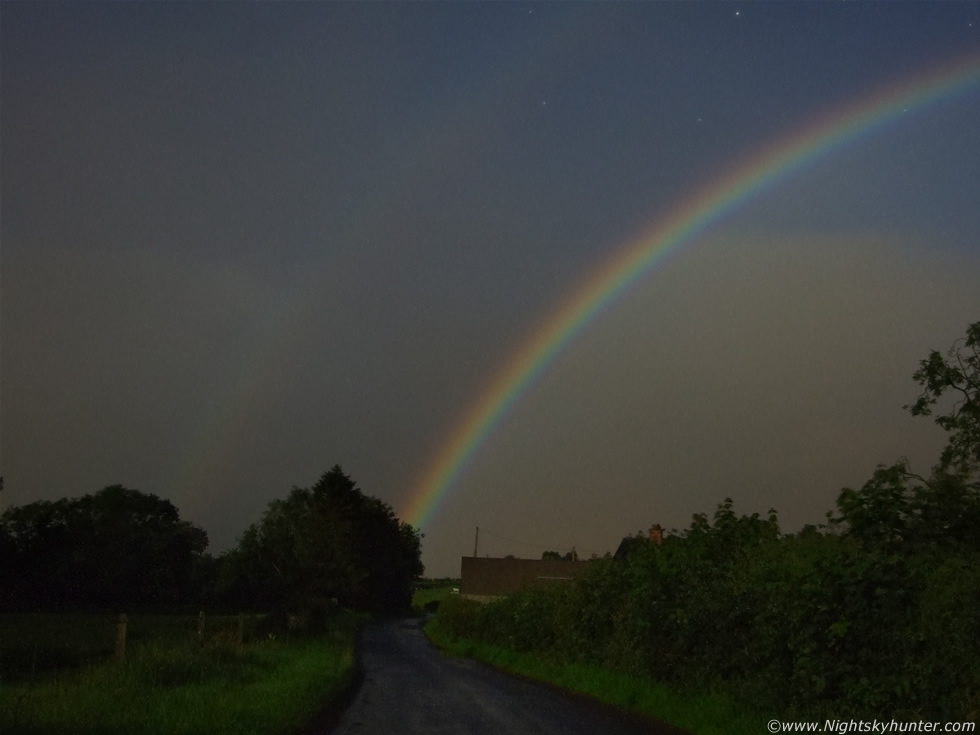 |
02.12 BST. During our walk we seen several more sets of bows but since the rain was too heavy I had to contend myself with watching them visually. Several miles later I was greeted with the most spectacular moonbow I have ever seen in my life. This was taken from deep in the country, facing NW. Heavy rain was falling in the distance however a dry slot was present over us which was perfect for photography so the camera was back out in a flash. This bow was big and stretched from the NW to NE. It was complete with AMAZING primary and secondary arcs. The colour was incredible and looked as striking as any high quality day time bow, It's a pity I didn't have my wide angle lens on to take in the entire scene. You can see both arcs very easily here with the 'bowl' of the Dipper at top.
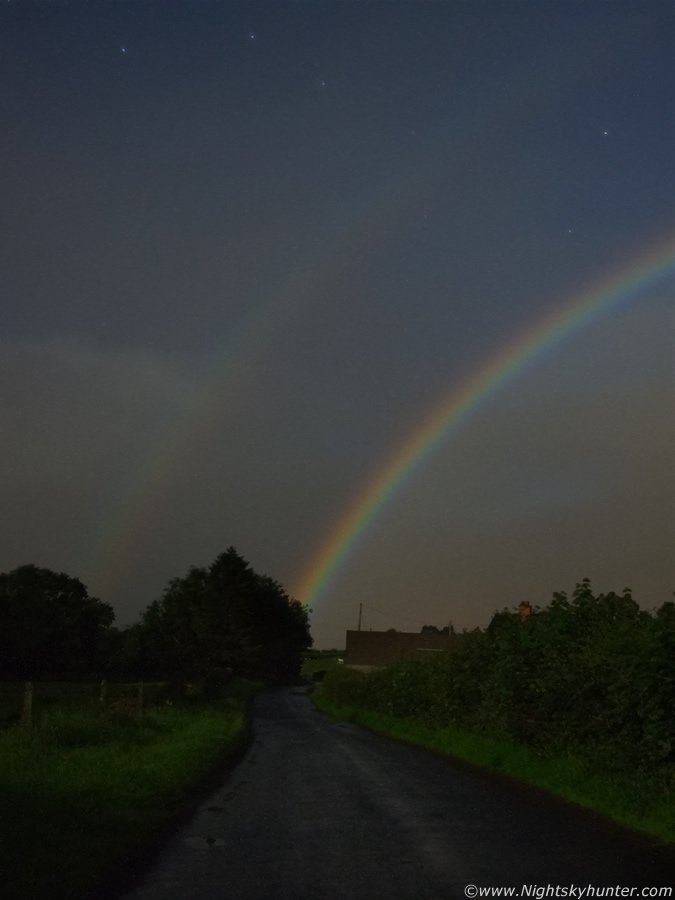 |
02.12 BST. Vertical shot with Plough Asterism intersected by the secondary.
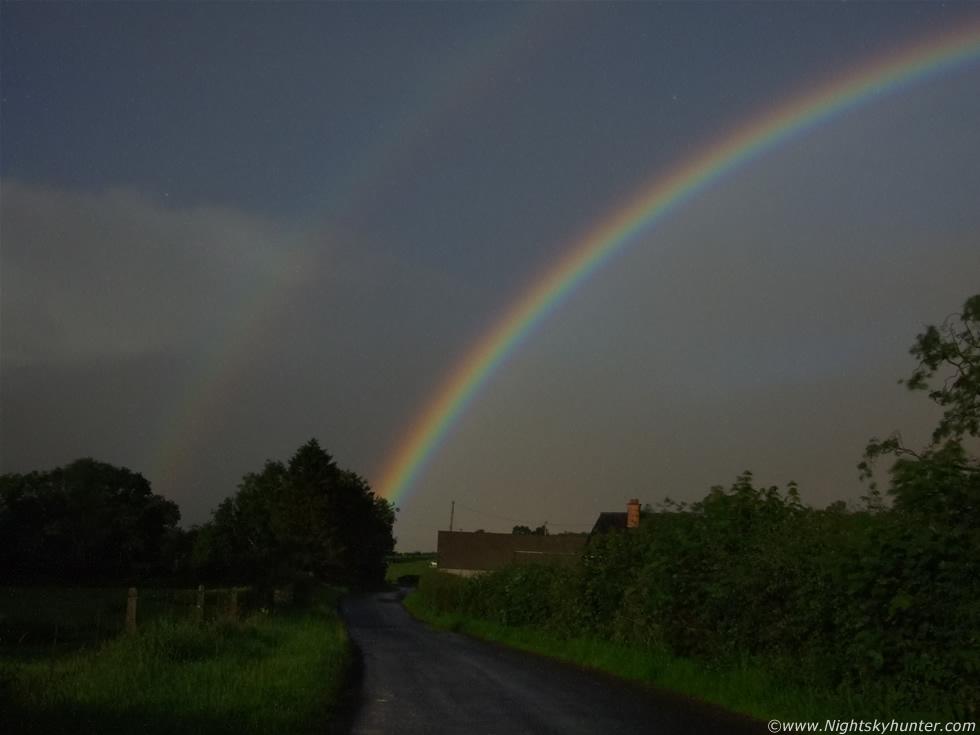 |
02.13 BST. They got even brighter. This almost looks like a day time shot. There is even a distinct Alexander's dark band between both arcs.
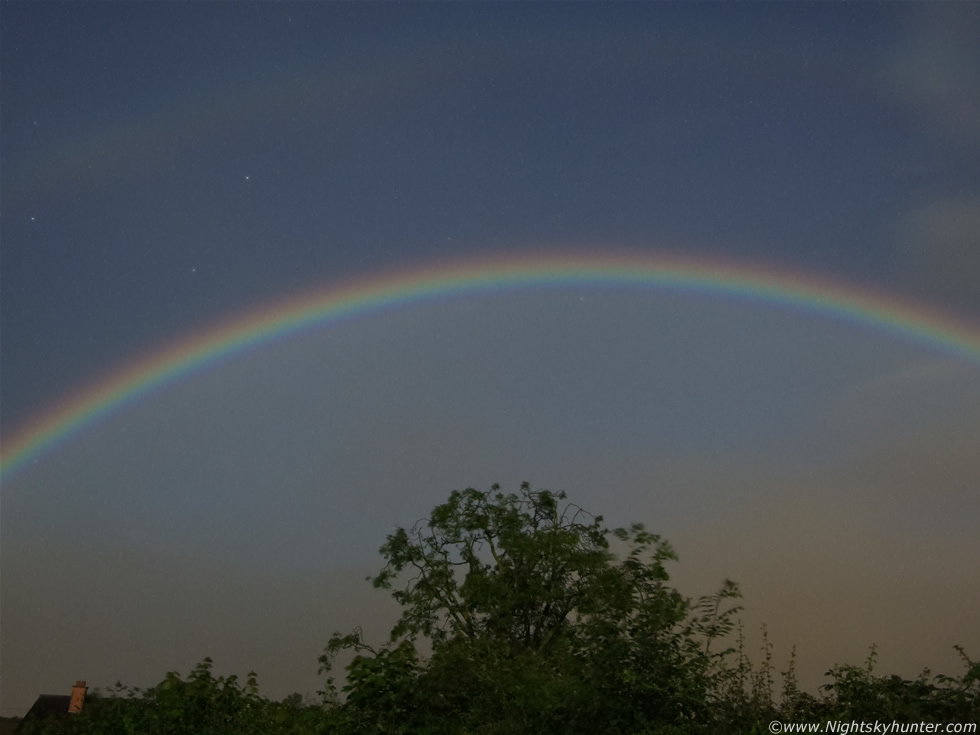 |
02.14 BST. Central moonbow with primary and secondary arcs along with Ursa Major.
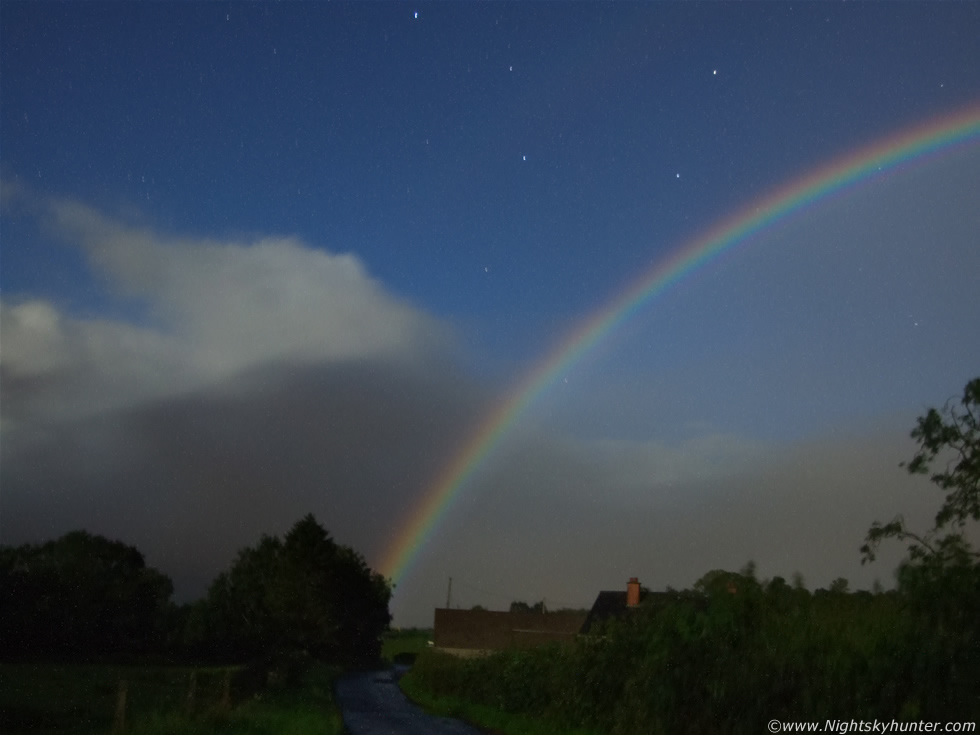 |
02.15 BST. This was my favourite image from the session and a sight I have never witnessed before. An intense primary moonbow with supernumerary arcs (SNAs) on the inside. The SNAs are most striking from the mid section of the bow to the top. One of the stars in the front paws of the celestial Bear can be seen behind the fainter SNAs!. Ursa Major is above with Coma Berenices above the clouds to the L. The clouds themselves are of the 'storm' variety. You can see a white anvil top catching the moonlight. Note that the stars on this image appeared trailed compared to the others. This is because Benson walked through my tripod legs and shook the camera briefly creating this effect.
By 03.00 BST we where back home to an overcast sky so I couldn't catch comet C/2007 W1 Boattini which was my other target for the night. By 03.45 the sky did clear but the twilight was too advanced for astronomical work so I called it a night. I have to say that I was absolutely amazed by these moonbows. I must have seen at least half a dozen sets during this session. The first was a beauty, however the last was unforgettable!!!. If you have never seen a moonbow before in your life then I urge you to hunt them out. They are so rare, so beautiful, and so photogenic. Maybe it's just me but I find these nocturnal bows to have a very eerie and haunting quality!. Do you agree?. All these images were taken with a 28mm lens at F/2.8 between ISO100-400 and exposures varying between 10 and 25 seconds using a Fujifilm S6500fd 6.3MP camera. Pity I had to put the images up at low resolution as the high res versions are so much better.
Martin McKenna